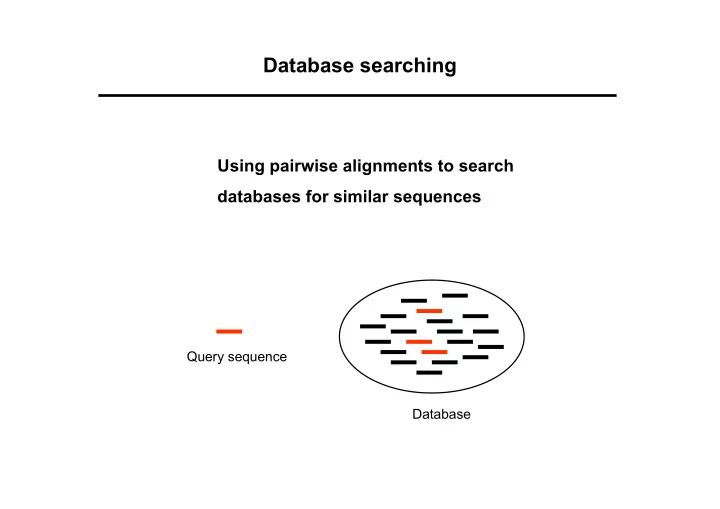

Database searching Using pairwise alignments to search databases for similar sequences Query sequence Database
Database searching Most common use of pairwise sequence alignments is to search databases for related sequences. For instance: find probable function of newly isolated protein by identifying similar proteins with known function. Most often, local alignment ( “Smith-Waterman”) is used for database searching: you are interested in finding out if ANY domain in your protein looks like something that is known. Often, full Smith-Waterman is too time-consuming for searching large databases, so heuristic methods are used (fasta, BLAST).
Database searching: heuristic search algorithms FASTA (Pearson 1995) BLAST (Altschul 1990, 1997) Uses heuristics to avoid Uses rapid word lookup methods calculating the full dynamic to completely skip most of the programming matrix database entries Speed up searches by an order Extremely fast of magnitude compared to full One order of magnitude Smith-Waterman faster than FASTA Two orders of magnitude The statistical side of FASTA is faster than Smith- still stronger than BLAST Waterman Almost as sensitive as FASTA
BLAST flavors BLASTN TBLASTN Nucleotide query sequence Protein query sequence Nucleotide database Nucleotide database ”On the fly” six frame translation of database BLASTP Protein query sequence TBLASTX Protein database Nucleotide query sequence Nucleotide database BLASTX Compares all reading frames of Nucleotide query sequence query with all reading frames of Protein database the database Compares all six reading frames with the database
Searching on the web: BLAST at NCBI Very fast computer dedicated to running BLAST searches Many databases that are always up to date Nice simple web interface But you still need knowledge about BLAST to use it properly
When is a database hit significant? • Problem : – Even unrelated sequences can be aligned (yielding a low score) – How do we know if a database hit is meaningful? – When is an alignment score sufficiently high? • Solution : – Determine the range of alignment scores you would expect to get for random reasons (i.e., when aligning unrelated sequences). – Compare actual scores to the distribution of random scores. – Is the real score much higher than you’d expect by chance?
Random alignment scores follow extreme value distributions Searching a database of unrelated sequences result in scores following an extreme value distribution The exact shape and location of the distribution depends on the exact nature of the database and the query sequence
Significance of a hit: one possible solution (1) Align query sequence to all sequences in database, note scores (2) Fit actual scores to a mixture of two sub-distributions: (a) an extreme value distribution and (b) a normal distribution (3) Use fitted extreme-value distribution to predict how many random hits to expect for any given score (the “E-value”)
Significance of a hit: example Search against a database of 10,000 sequences. An extreme-value distribution (blue) is fitted to the distribution of all scores. It is found that 99.9% of the blue distribution has a score below 112. This means that when searching a database of 10,000 sequences you’d expect to get 0.1% * 10,000 = 10 hits with a score of 112 or better for random reasons 10 is the E-value of a hit with score 112. You want E-values well below 1!
Database searching: E-values in BLAST BLAST uses precomputed extreme value distributions to calculate E- values from alignment scores For this reason BLAST only allows certain combinations of substitution matrices and gap penalties This also means that the fit is based on a different data set than the one you are working on A word of caution: BLAST tends to overestimate the significance of its matches E-values from BLAST are fine for identifying sure hits One should be careful using BLAST’s E-values to judge if a marginal hit can be trusted (e.g., you may want to use E-values of 10 -4 to 10 -5 ).
Recommend
More recommend